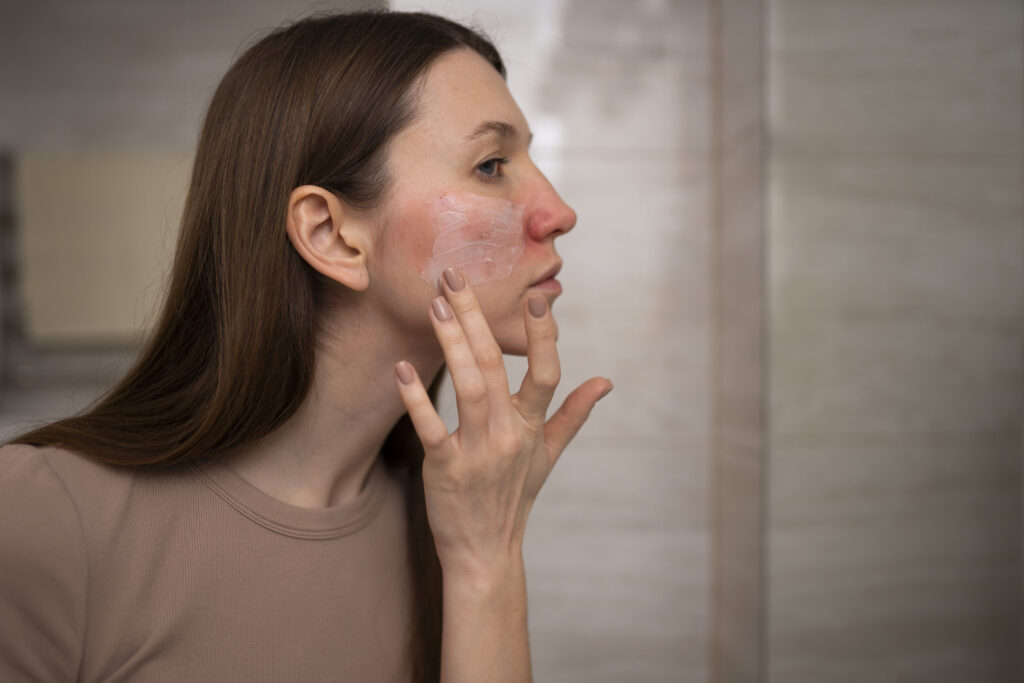When you think about skin conditions, rosacea might not be the first thing that comes to mind. However, it’s a common issue for many people. Rosacea often shows up as a redness on the face. This redness can be mistaken for blushing or a rash. But it’s more than skin deep. Understanding rosacea is key to calming its effects and finding suitable treatments.
Explore the Common Symptoms of Rosacea and How to Identify Them Early on for Timely Treatment
So, what are the tell-tale signs of rosacea? It typically begins with facial redness, which might flare up and worsen over time. This redness is a result of blood vessels under the skin growing more visible. You might also notice small, red bumps that can appear like acne. But unlike acne, these bumps do not contain pus.
Another symptom is facial swelling. In some rosacea cases, the skin on the nose and cheeks thickens. The eyes might even get irritated. Early detection is important to manage these symptoms effectively. Regular observation of any persistent changes in your facial skin can prompt timely consultation and lead to effective management plans.
Discuss Prevalent Rosacea Triggers Such as Dietary Habits, Stress, and Weather Conditions, Especially in India
Different things can trigger rosacea. Many people find that certain foods, like spicy dishes or alcohol, can cause flare-ups. Stress is also a major contributor. When stress levels go up, so does skin irritation.
Weather plays an important role too. In India, the hot and humid climate can aggravate rosacea. Exposure to the sun without proper protection is a common trigger. Seasonal changes, such as the shift from hot to cold, can also lead to flare-ups.
Here are some common rosacea triggers: – Hot drinks and spicy food – Temperature fluctuations – Sun exposure – Emotional stress – Alcohol consumption
Awareness of these triggers helps in taking steps to avoid them, minimizing the possibility of flare-ups and maintaining better skin health.
Highlight Lifestyle and Dietary Changes that Can Help Manage Rosacea Symptoms Effectively
Managing rosacea starts with lifestyle adjustments. Pay attention to your diet. Cut down on spicy and hot foods, as well as alcohol. Opt for cooler and mild foods.
Having a good skincare routine can help greatly. Use gentle, non-irritating products. Regular moisturizing can prevent dryness and irritation, crucial for rosacea skin. Wearing sunscreen daily is also vital, as it protects sensitive skin from harmful UV rays.
Stress management techniques, like yoga or meditation, can help minimize stress-related triggers, leading to a more balanced lifestyle. By adopting these changes, the impact of rosacea can be managed, allowing for healthier skin and improved well-being.
Natural Remedies and Modern Treatments: A Blend for Calming Rosacea
Explore the Role of Herbal Remedies in India, Focusing on Neem and Turmeric, That Might Soothe Rosacea Symptoms
Nature often offers simple solutions. In India, herbs like neem and turmeric are known for their healing properties. Neem, with its anti-inflammatory elements, is said to reduce the redness and swelling linked to rosacea. Applying crushed neem leaves as a face mask might offer relief.
Turmeric, often found in Indian kitchens, also helps. It’s famous for its anti-inflammatory and antioxidant benefits. Adding a pinch of turmeric to your diet or using it in a skincare routine can potentially ease the symptoms.
By exploring these herbal solutions, individuals might find ways to reduce rosacea symptoms without the use of synthetic products. These natural remedies provide an affordable and accessible option for those seeking to enhance their rosacea skin care regimen.
Highlight the Latest Innovative Treatments for Rosacea, Including Prescriptions and Advanced Therapies
While natural remedies have their place, modern medicine offers advanced solutions. Rosacea redness treatment has seen progress through various prescription medications that target inflammation and redness. These include topical gels and creams prescribed by dermatologists to manage and reduce symptoms effectively.
Laser therapy is another innovative approach. It targets visible blood vessels, reducing redness and improving skin appearance. Laser treatment is especially beneficial for individuals seeking long-term improvements.
Oral antibiotics can also be prescribed to address inflammation. These medications, coupled with other treatments, provide a comprehensive approach for those struggling with persistent rosacea symptoms.
Navigating Rosacea with Professional Help and Future Innovations
The Significance of Early Diagnosis and Seeking Professional Advice When Symptoms Persist
When rosacea symptoms persist, seeing a dermatologist is crucial. An early diagnosis can lead to personalized treatment plans. Professionals offer advice on lifestyle changes and treatments tailored to individual needs, ensuring the most effective management plan.
Seeking professional advice early promises a proactive approach to managing rosacea, paving the way for healthier skin and improved confidence.
Examine Advancements in Dermatological Research Leading to Better Rosacea Treatments and Skincare Options
Advances in research are paving new paths in rosacea therapy. Scientists are working on developing better medication and treatment options. These innovations offer hope for those dealing with long-term symptoms.
With continual advancements, the future holds the promise of comprehensive treatment options, ensuring individuals can lead a life with minimized discomfort from rosacea symptoms.
Incorporating these latest developments into daily routines will undoubtedly enhance face care for rosacea and overall skin health.
